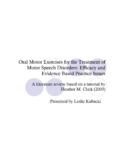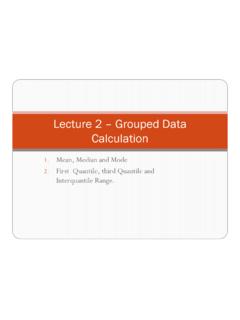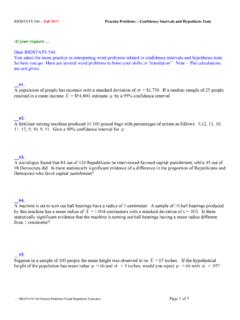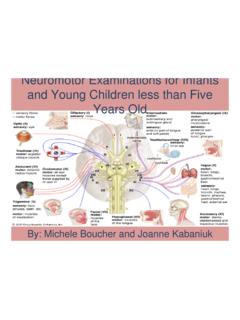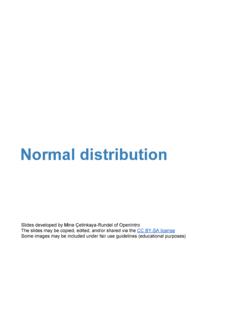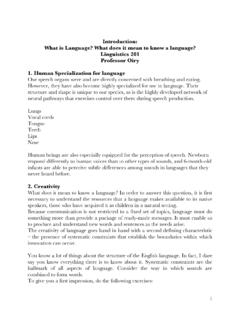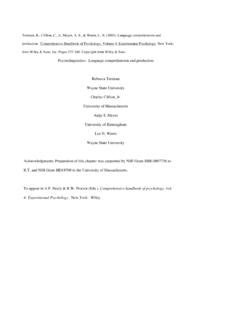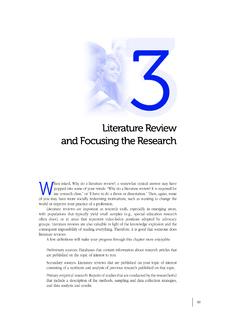Transcription of Critical Thinking and Transferability: A Review of the ...
1 Critical Thinking and transferability : A Review of the literature By Gwendolyn Reece April 9, 2002 Since the 1960s, concern that American students may not be capable of transferring the skills they have gained from their education to the practical problems of life has troubled educators. Of greatest concern is whether students have mastered Critical Thinking or higher order Thinking skills and can apply them outside of school curricula. These concerns have given rise to the Critical Thinking movement. To demonstrate that the movement is successful, it must prove that its efforts not only increase the Critical Thinking of students in school, but that students can transfer Critical Thinking to novel situations, including those encountered in daily life. The primary purpose of this Review is to ascertain if there is compelling evidence that efforts to teach Critical Thinking have had this result.
2 What became apparent in the process of this Review , however, was that several subsidiary problems must first be answered before the problem of evaluating the effectiveness of Critical Thinking transfer can be approached. The first of these problems is whether the movement has a common theme or definition of Critical Thinking . Second is the question, does Critical Thinking encompass creative Thinking or is it antithetical to it. The third problem might be formulated thus: is Critical Thinking generalizable or is it tied to subject matter? The fourth problem is whether adequate evaluative measures of Critical Thinking are available to measure the effectiveness of efforts to teach Critical Thinking . Answering these prior question is essential before inquiring whether there is compelling evidence that teaching Critical Thinking results in a transfer of skills or dispositions that students can use in other arenas.
3 This line of inquiry supplies the structure for this Review of the relevant literature . The scope of this Review is limited. Most Critical Thinking literature provides program and instructional technique description. This material is out of scope for this Review except as it bears directly upon the question concerning subject-dependence in relation to Critical Thinking . Furthermore, although this Review addresses the works of most seminal thinkers in the Critical Thinking movement, constraints and limited access to information means that some major figures, such as Harvey Siegel, have not been included. Finally, although philosophical literature on this subject abounds, evaluative studies using either qualitative or quantitative methods to measure the effectiveness of whole programs are comparatively scarce.
4 I have included relevant examples of these studies, yet it can be said at the outset that the dearth such studies needs to be redressed by the research community. The Common Theme of the Critical Thinking Movement The first step in understanding the Critical Thinking Movement is to uncover the essential characteristics of Critical thought and examine the commonality of agendas for States why subject is important. States purpose of this Review . Establishes limits of project s scope. Identifies gaps in existing research. Previews logical order the Review will follow. Long reviews are often broken by headings and subheadings corresponding to the organization outlined in the introduction. Gwendolyn Reece might have written a traditional research paper describing the history of Critical Thinking in American education and containing quotations from scholarly sources to support her ideas.
5 Instead, she presents a literature Review focusing on the scholarly sources themselves. Reece explains how scholarly opinion has developed over time, where leading scholars agree and disagree, what sources carry more authority than others, and finally where more research is needed. 2the Critical Thinking Movement. Proponents of the Critical Thinking movement posit numerous reasons for teaching Critical Thinking . A common reason is a reflection of the shift in economic patterns away from an industrial society into arenas in which laborers must solve complex problems (Bloom; Reich; Paul; Nickerson). Another reason frequently proposed is that Critical Thinking skills are necessary for effective citizenship in a democracy, for example, in selecting leaders and being a juror (Ennis, Taxonomy ; Paul; Nickerson).
6 Paul and Nickerson also call attention to the capacity of human beings for self-delusion and note that irrational human behavior causes great suffering in the world. They see Critical Thinking the antidote. Finally, both these thinkers uphold the notion that Thinking is a significant part of being human; therefore, mastery of Critical Thinking is a necessary for being a fully developed human being. Another premise of the proponents of the Critical Thinking movement is that Critical Thinking does not always unfold naturally as a part of growth. Furthermore, Critical Thinking is not effectively taught in traditional school settings that rely heavily upon rote memorization and didactic teaching methods (Kennedy; Paul; Nickerson; Schrag). Therefore, leaders of the movement have developed numerous programs to teach Critical Thinking .
7 The common theme of the Critical Thinking movement is that Critical Thinking skills involve the ability to make reasonable decisions in complex situations, such as those found in a rapidly changing and complex society. The movement emphasizes knowing how more than knowing that (Roland). Furthermore, helping individuals gain these abilities, requires a self-conscious attempt on the part of educators to address the cultivation of Critical Thinking by utilizing methods other than simply rote memorization and didactic instruction. What is Critical Thinking ? The unity of the movement disintegrates once the question what do you mean by Critical Thinking ? is asked. There is a significant divergence of opinion about what constitutes Critical Thinking . Some scholars identify Critical Thinking with the mastery of specific skill sets and provide schematics or taxonomies to express their inter-relationships.
8 A Committee of College and University Examiners created one of the early taxonomies (Bloom). Bloom and his colleagues identified six major classes of cognitive skills: Knowledge (by which they mean recall); Comprehension; Application; Analysis; Synthesis; and Evaluation. One reason for this construction is that the lower skills are required in order for the higher skills to be used. Comprehension requires Knowledge, or recall. Therefore, Critical Thinking , in Bloom s view, is gaining mastery of these skill sets and selecting the appropriate techniques when encountering a novel situation. The primary strength of Bloom s taxonomy is that it is logical and hierarchical, guiding the educator in a process leading from the most simple to the most complex form of cognitive skills. It is also comparatively easy to evaluate the mastery of these skills because they link to particular behaviors (Bloom 12).
9 Bloom supplies numerous evaluative techniques linked to the taxonomy. A position held by a number of experts is summarized, and those experts are included in an in-text citation following MLA style. Note difference from an annotated bibliography: the same source may be cited more than once. Points out strengths & weaknesses of leaders in the field. 3 There are, however, disadvantages with Bloom s taxonomy. Historically, many teachers have used it as a cookbook without demonstrating Critical Thinking skills themselves (Paul 375-383). Paul also criticizes Bloom for overemphasizing recall and for insisting on neutrality. Paul believes that Critical Thinking should be used to reach substantial value judgments. Finally, Paul conceives Bloom s taxonomy as neglecting the dialectical dynamic of Critical Thinking .
10 With regard to his first point, Paul overstates his case; misuse of the taxonomy does not invalidate the design itself. The emphasis given to Knowledge or recall is more controversial, relating to the question whether or not Critical Thinking is subject-dependent. I do believe that Paul is correct in criticizing Bloom s view that Critical Thinking is value neutral, since real life decisions are never value neutral; but again, that does not invalidate the structure of his taxonomy. The neglect of the dialectical process in Critical Thinking , however, is a substantial criticism that does seem borne out in the construction of the taxonomy, which is designed to flow from simple to complex. Another general criticism of defining Critical Thinking as being comprised of a set of skills is that Critical thought also requires particular dispositions or habits to use those skills.
